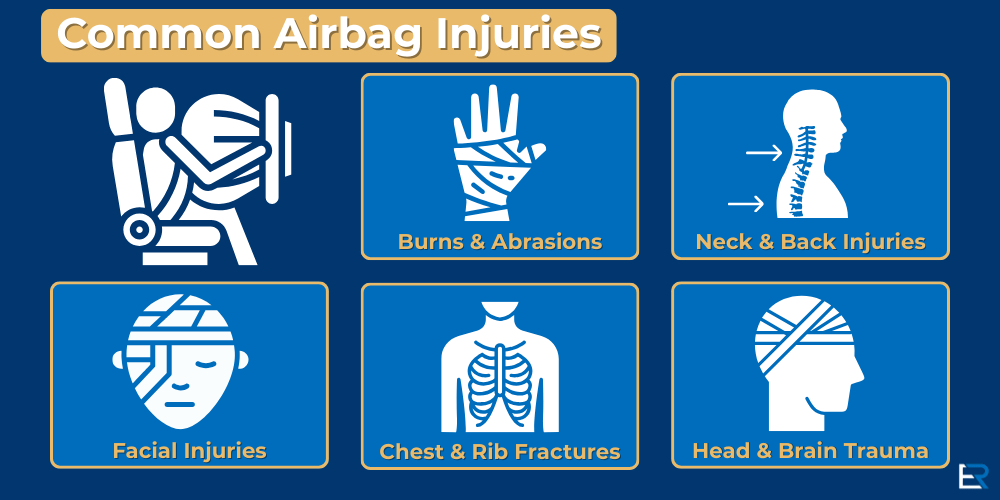Airbags save lives every day on California roads. But when they deploy with extreme force or malfunction, they can leave drivers and passengers with serious, sometimes life-changing injuries, such as broken bones, burns, or airbag injuries to arms and hands. Recovery may take weeks, months, or even years.
Types of Airbag Injuries and Their Long-Term Effects
Airbag injuries aren’t always simple scrapes or bruises. Many victims experience broken bones, burns, or even long-term medical issues. Understanding what kinds of injuries airbags cause can help you prepare for the road to recovery.
Some of the injuries caused by airbags include:
- Facial injuries – such as broken noses, dental damage, or deep cuts when the airbag slams forward.
- Burns and abrasions – often caused by the chemicals inside the airbag or the friction of deployment against the skin.
- Neck and back injuries – whiplash, herniated discs, or lasting pain from the sudden jolt of impact.
- Chest and rib fractures – from the airbag striking the chest with tremendous force.
- Head and brain trauma – including concussions or more severe injuries if the head is thrown into the airbag.
Some victims face long-term effects such as scarring, reduced mobility, vision or hearing loss, and even post-traumatic stress. Children, elderly passengers, and smaller adults are especially at risk.

Airbag Safety: Lives Saved vs. Injuries Caused
According to the Insurance Institute for Highway Safety (IIHS) and the National Highway Traffic Safety Administration (NHTSA), although they save thousands of lives each year, airbags have also been linked to serious injuries and even deaths, especially in older vehicles.
- 290 deaths – Between 1990 and 2008, more than 290 deaths were caused by airbags inflating in low-speed crashes.
- Children are most at risk – Over 90% of child deaths occurred when kids were unbelted or in rear-facing car seats placed in the front seat.
- Other vulnerable groups – Shorter and elderly drivers, who often sit closer to the steering wheel, were more likely to suffer severe injuries.
- Improvements over time – Federal rules in 1998 and 2007 required “advanced airbags” that deploy with less force and adjust for smaller drivers and children. Today, serious injuries from properly functioning airbags are far less common.
- Defective airbags remain a danger – The Takata recall affected over 67 million vehicles. NHTSA reports at least 18 U.S. deaths and more than 400 injuries, with California among the hardest-hit states.
These numbers show both sides of the story: while airbag deployment saves lives, the side effects of airbag deployment, such as burns or chemical irritation, shouldn’t be overlooked. The risks are even greater when airbags are defective or when children and vulnerable adults are exposed to deployment forces.
Takata Airbag Recall
The Takata airbag recall is the largest auto safety recall in U.S. history, involving more than 67 million vehicles from dozens of automakers. Investigators found that these airbags have defective inflators that can explode when deployed, sending sharp metal fragments into drivers and passengers.
According to the National Highway Traffic Safety Administration (NHTSA), defective airbags have killed 18 people in the U.S. and injured over 400. With millions of affected vehicles still on the road, California drivers remain at serious risk if recalls go unchecked.
If you want to check whether your vehicle is part of the Takata recall or another airbag recall, visit the National Highway Traffic Safety Administration’s (NHTSA) website.
Symptoms of Airbag Injuries You Shouldn’t Ignore
Not all injuries are immediately visible. Some appear hours or even days after the crash, making it easy to dismiss them as “minor.” But ignoring early symptoms can lead to long-term health problems.
These could signal a serious injury:
- Headaches, dizziness, or confusion – possible signs of a concussion or brain injury.
- Shortness of breath or chest pain – which may point to internal injuries.
- Abdominal pain or swelling – could mean internal bleeding.
- Numbness, tingling, or weakness – signs of nerve or spinal damage.
- Persistent burns, bruises, or cuts – which can lead to infections or scarring if untreated.
- Swelling, bruising, or restricted movement in the arms — a common sign of airbag injuries to arms or hands sustained during deployment.
If you notice any of these, seek medical attention immediately. Documenting these symptoms not only protects your health but also strengthens your claim if you pursue compensation.
Airbag Recalls and Legal Rights for Injury Victims

Airbags don’t always work the way they should. Millions of vehicles in California have been recalled for dangerous defects, including the massive Takata airbag recall, the largest in U.S. history.
These defective airbags could explode, fail to deploy, or go off unexpectedly, putting drivers and passengers at serious risk.
Because so many people drive in California, these recalls have heavily impacted the state. Under California’s strict liability law, manufacturers can be held responsible for defective airbags, even if they didn’t intend for them to be unsafe.
Recommended Reading:
- When Do Airbags Deploy? Speed, Impact, and Safety Thresholds Explained
- How Airbag Deployment Affects Your Car’s Value and Insurance Claims
Types of Compensation Available to Airbag Victims
For victims, the damage often goes beyond the crash. Defective airbags can mean surgeries, rehab, and long-term treatment for burns or chronic pain. Even when not defective, the side effects of airbag deployment may still cause lingering pain, burns, or scarring that need medical care.
These costs add up quickly and can overwhelm families. If you’ve been hurt by a faulty airbag, you may be entitled to compensation for:
- Medical expenses – may include surgeries or therapy for airbag injuries to arms, chest, or other areas impacted during deployment.
- Lost wages – income you miss while recovering or reduced earning capacity.
- Pain and suffering – the physical and emotional impact on your life.
Because defective airbag cases often involve large manufacturers or corporations, settlements can be substantial. These companies have teams of lawyers protecting their bottom line, which makes it critical to have an experienced attorney fighting for the full value of your claim.
How Our Car Accident Lawyers Can Protect Your Rights After an Airbag Injury
Airbag cases often involve both accident law and product liability law, which makes them more complex than the average car crash claim. Our car accident lawyer can guide you through this process and make sure you aren’t left dealing with the costs on your own.
Here’s how our California personal injury attorney can help you after an airbag injury:
- Investigate liability – Determine if the airbag was defective, failed to deploy properly, or caused unnecessary harm, and identify all parties who may be responsible.
- Gather strong evidence – Collect medical records, crash reports, recall notices, and expert testimony to clearly connect the airbag to your injuries.
- Handle complex claims – Manage claims against negligent drivers, large manufacturers, dealerships, or mechanics who may share responsibility.
- Pursue full compensation – Fight to recover the true value of your case, including medical bills, future care needs, lost wages, and pain and suffering.
Contact Our Car Accident Attorney for a Free Consultation Today!

Airbag injuries can lead to overwhelming medical bills, time away from work, and long-term challenges that affect your daily life. If you’re dealing with the side effects of airbag deployment, from lingering pain to permanent scarring, you don’t have to face it alone.
With over 20 years of experience and more than $224 million recovered for California clients, our attorneys know how to hold automakers and insurers accountable.
Contact El Dabe Ritter Trial Lawyers today for a free case review—you pay nothing unless we win.
Disclaimer: The information provided in this blog post is not intended as legal advice and should not be relied upon as such. You should consult with an experienced attorney for advice on your specific situation.
